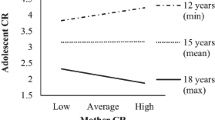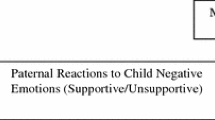Abstract
We examined the direct relationships between parent and child emotion regulation (ER) strategy use during the transitionary and understudied developmental periods of middle childhood through to adolescence. Three hundred and seventy-nine participants aged between 9 and 19 years, completed the Emotion Regulation Questionnaire for Children and Adolescents. In addition, 358 of their mothers and 207 of their fathers completed the Emotion Regulation Questionnaire. Providing partial support for the hypothesis, maternal use of the ER Expressive Suppression strategy was significantly predictive of their child’s use of Suppression. However, paternal ER strategy use was unrelated to their child’s ER strategy use. Child age did not moderate the relationships investigated. These findings suggest that children’s ER during middle childhood and adolescence is more closely related to the ER of their mother than their father. It is proposed that this may be accounted for by emotion socialization processes.
Similar content being viewed by others
References
Bariola, E., Gullone, E., & Hughes, E. K. (in press). Child and adolescent emotion regulation: The role of parental emotion regulation and expression. Clinical Child & Family Psychology Review.
Betts, J., Gullone, E., & Allen, J. S. (2009). An examination of emotion regulation, temperament, and parenting style as potential predictors of adolescent depression risk status: A correlational study. British Journal of Developmental Psychology, 27, 473–485.
Bridges, L. J., Denham, S. A., & Ganiban, J. M. (2004). Definitional issues in emotion regulation research. Child Development, 75, 340–345.
Calkins, S. D., & Johnson, M. C. (1998). Toddler regulation of distress to frustrating events: Temperamental and maternal correlates. Infant Behavior & Development, 21, 379–395.
Cassano, M., Perry-Parrish, C., & Zeman, J. (2007). Influence of gender on parental socialization of children’s sadness regulation. Social Development, 16, 210–231.
Cohen, J. (1988). Statistical power analysis for the behavioral sciences (2nd ed.). Mahwah, NJ: Lawrence Erlbaum Associates.
Cole, P. M., Martin, S. E., & Dennis, T. A. (2004). Emotion regulation as a scientific construct: Methodological challenges and directions for child development research. Child Development, 75, 317–333.
Denham, S. A. (1998). Emotional development in young children. New York: The Guilford Press.
Eisenberg, N., Gershoff, E. T., Fabes, R. A., Shepard, S. A., Cumberland, A. J., Losoya, S. H., et al. (2001). Mothers’ emotional expressivity and children’s behavior problems and social competence: Mediation through children’s regulation. Developmental Psychology, 37, 475–490.
Eisenberg, N., & Morris, A. S. (2002). Children’s emotion-related regulation. In H. Reese & R. Kail (Eds.), Advances in child development and behavior (Vol. 30, pp. 189–229). San Diego, CA: Academic Press.
Eisenberg, N., Valiente, C., Morris, A. S., Fabes, R. A., Cumberland, A., Reiser, M., et al. (2003). Longitudinal relations among parental emotional expressivity, children’s regulation, and quality of socioemotional functioning. Developmental Psychology, 39, 3–19.
Eisenberg, N., Zhou, Q., Spinrad, T. L., Valiente, C., Fabes, R. A., & Liew, J. (2005). Relations among positive parenting, children’s effortful control, and externalizing problems: A three-wave longitudinal study. Child Development, 76, 1055–1071.
Fivush, R., Brotman, M. A., Buckner, J. P., & Goodman, S. H. (2000). Gender differences in parent-child emotion narratives. Sex Roles, 42, 233–253.
Garber, J., Braafladt, N., & Zeman, J. (1991). The regulation of sad affect: An information-processing perspective. In J. Garber & K. A. Dodge (Eds.), The development of emotion regulation and dysregulation (pp. 208–240). New York, USA: Cambridge University Press.
Garside, R. B., & Klimes-Dougan, B. (2002). Socialization of discrete negative emotions: Gender differences and links with psychological distress. Sex Roles, 47, 115–128.
Greenberg, M. T., Lengua, L. J., Coie, J. D., Pinderhughes, E. E., Bierman, K., Dodge, K. A., et al. (1999). Predicting developmental outcomes at school entry using a multiple-risk model: Four American communities. Developmental Psychology, 35, 403–417.
Gross, J. J. (1998). The emerging field of emotion regulation: An integrative review. Review of General Psychology, 2, 271–299.
Gross, J. J. (2001). Emotion regulation in adulthood: Timing is everything. Current Directions in Psychological Science, 10, 214–219.
Gross, J. J., & John, O. P. (2003). Individual differences in two emotion regulation processes: Implications for affect, relationships, and well-being. Journal of Personality and Social Psychology, 85, 348–362.
Gullone, E. (2010). The emotion regulation questionnaire for children and adolescents (ERQ-CA): A psychometric evaluation. Manuscript submitted for publication.
Gullone, E., Hughes, E. K., King, N. J., & Tonge, B. (2010). The normative development of emotion regulation strategy use in children and adolescents: A 2-year follow-up study. Journal of Child Psychology and Psychiatry, 51, 567–674.
Hughes, E.K., Gullone, E., & Watson, S.D. (in press). Emotional functioning of children and adolescents with elevated depressive symptoms. Journal of Psychopathology and Behavioral Assessment.
Hughes, E. K., Gullone, E., Dudley, A., & Tonge, B. (2010). A case-control study of emotion regulation and school refusal in children and adolescents. Journal of Early Adolescence, 30, 691–706.
Jaffe, M., Gullone, E., & Hughes, E. K. (2010). The roles of temperamental dispositions and perceived parenting behaviours in the use of two emotion regulation strategies in late childhood. Journal of Applied Developmental Psychology, 31, 47–59.
John, O. P., & Gross, J. J. (2004). Healthy and unhealthy emotion regulation: Personality processes, individual differences, and life span development. Journal of Personality, 72, 1301–1333.
Klimes-Dougan, B., Brand, A. E., Zahn-Waxler, C., Usher, B., Hastings, P. D., Kendziora, K., et al. (2007). Parental emotion socialization in adolescence: Differences in sex, age and problem status. Social Development, 16, 326–342.
Lamb, M. E. (Ed.). (2004). The role of the father in child development (4th ed.). New Jersey: Wiley.
Larson, R. W., Richards, M. H., Moneta, G., Holmbeck, G., & Duckett, E. (1996). Changes in adolescents’ daily interactions with their families from ages 10 to 18: Disengagement and transformation. Developmental Psychology, 32, 744–754.
McDowell, D. J., Kim, M., O’Neil, R., & Parke, R. D. (2002). Children’s emotional regulation and social competence in middle childhood: The role of maternal and paternal interactive style. Marriage & Family Review, 34, 345–364.
Morris, A. S., Silk, J. S., Steinberg, L., Myers, S. S., & Robinson, L. R. (2007). The role of the family context in the development of emotion regulation. Social Development, 16, 361–388.
Parke, R. D. (1994). Progress, paradigms, and unresolved problems: A commentary on recent advances in our understanding of children’s emotions. Merrill-Palmer Quarterly: Journal of Developmental Psychology, 40, 157–169.
Silk, J. S., Shaw, D. S., Skuban, E. M., Oland, A. A., & Kovacs, M. (2006). Emotion regulation strategies in offspring of childhood-onset depressed mothers. Journal of Child Psychology and Psychiatry, 47, 69–78.
Spear, L. P. (2000). Neurobehavioral changes in adolescence. Current Directions in Psychological Science, 9, 111–114.
Tabachnick, B. G., & Fidell, L. S. (2007). Using multivariate statistics (5th ed.). New York: Pearson Education Inc.
Thompson, R. A. (1994). Emotion regulation: A theme in search of definition. Monographs of the Society for Research in Child Development, 59, 25–52.
Acknowledgments
This work was supported by an Australian Research Council Discovery Project grant [DP0771180].
Author information
Authors and Affiliations
Corresponding author
Rights and permissions
About this article
Cite this article
Bariola, E., Hughes, E.K. & Gullone, E. Relationships Between Parent and Child Emotion Regulation Strategy Use: A Brief Report. J Child Fam Stud 21, 443–448 (2012). https://doi.org/10.1007/s10826-011-9497-5
Published:
Issue Date:
DOI: https://doi.org/10.1007/s10826-011-9497-5




